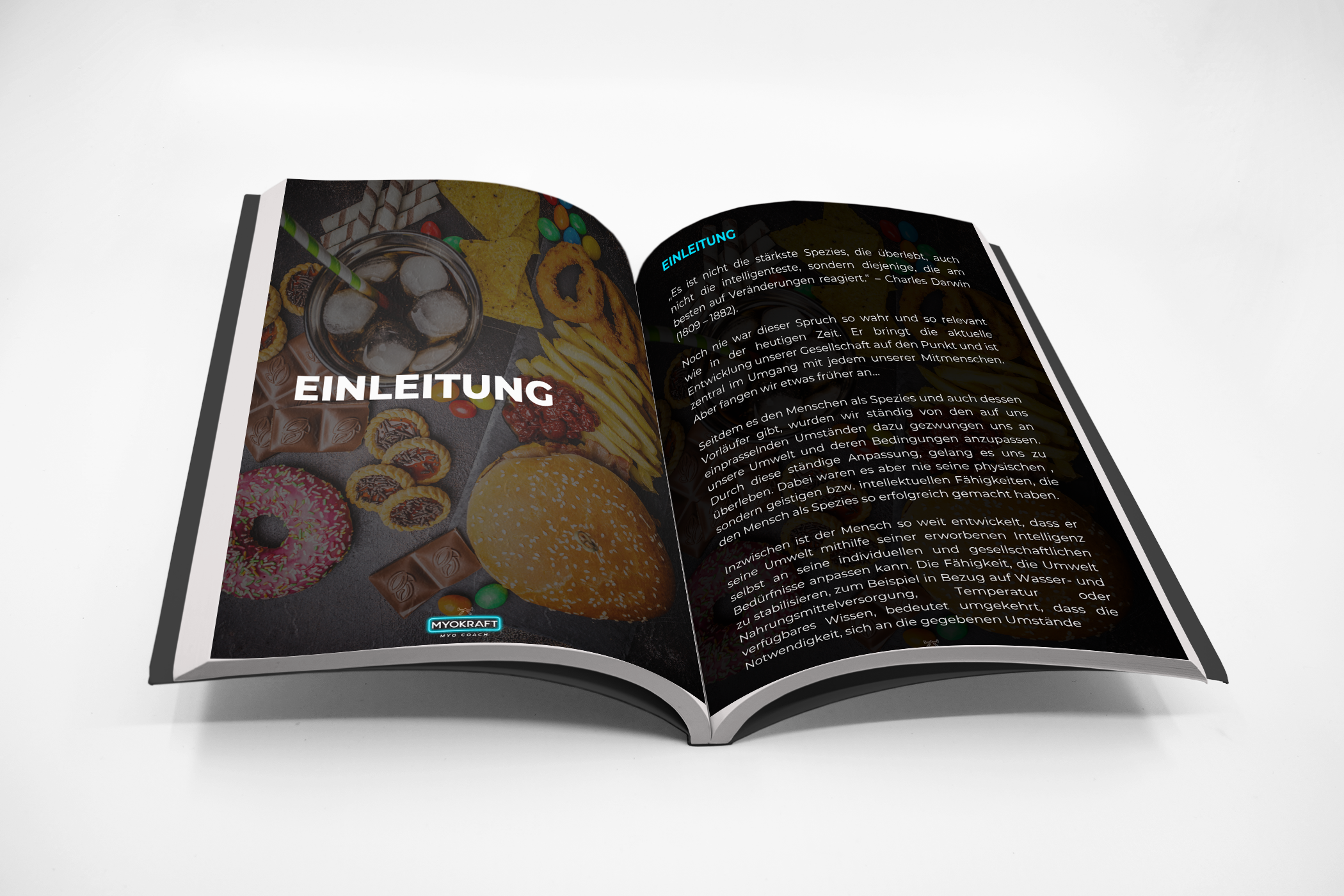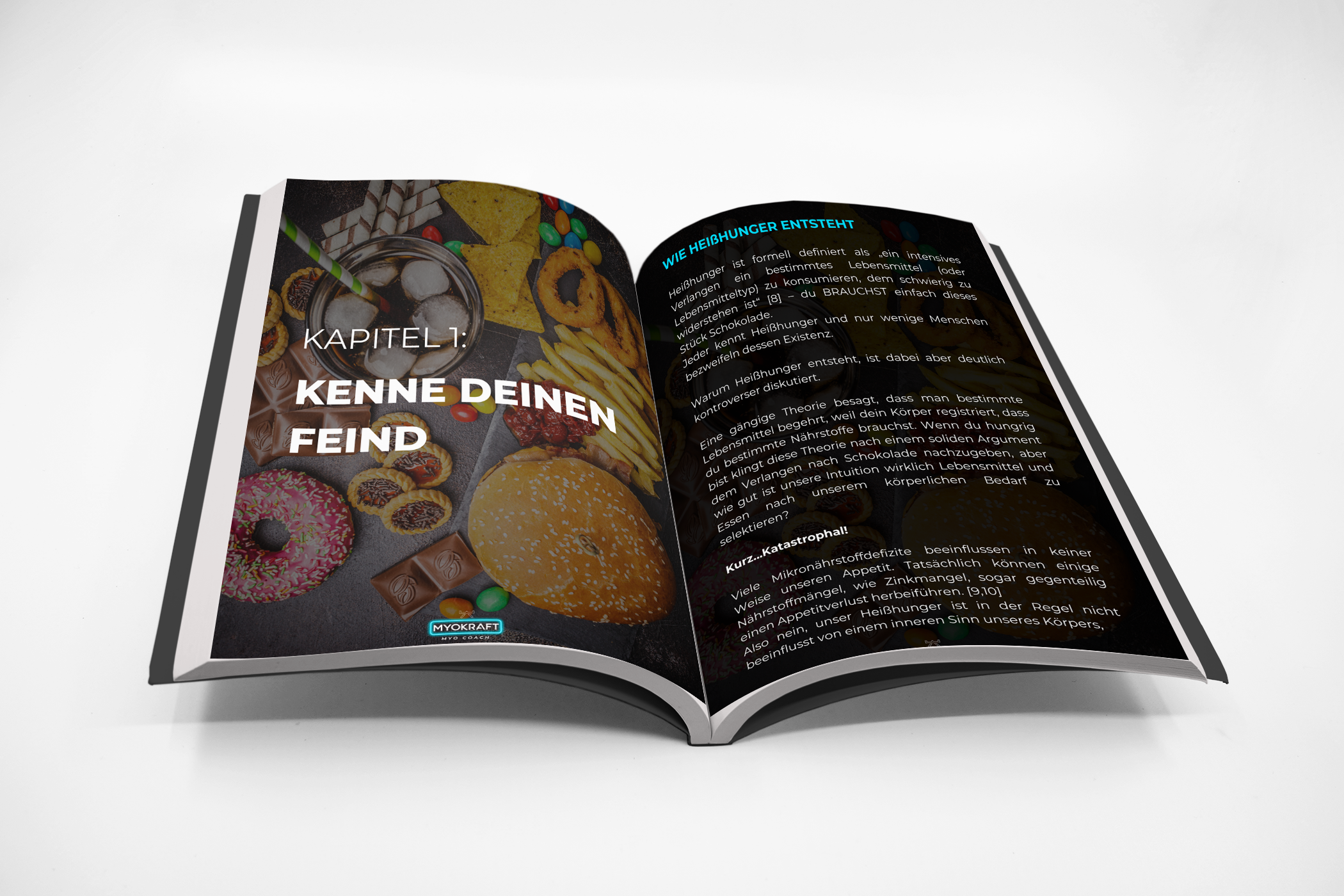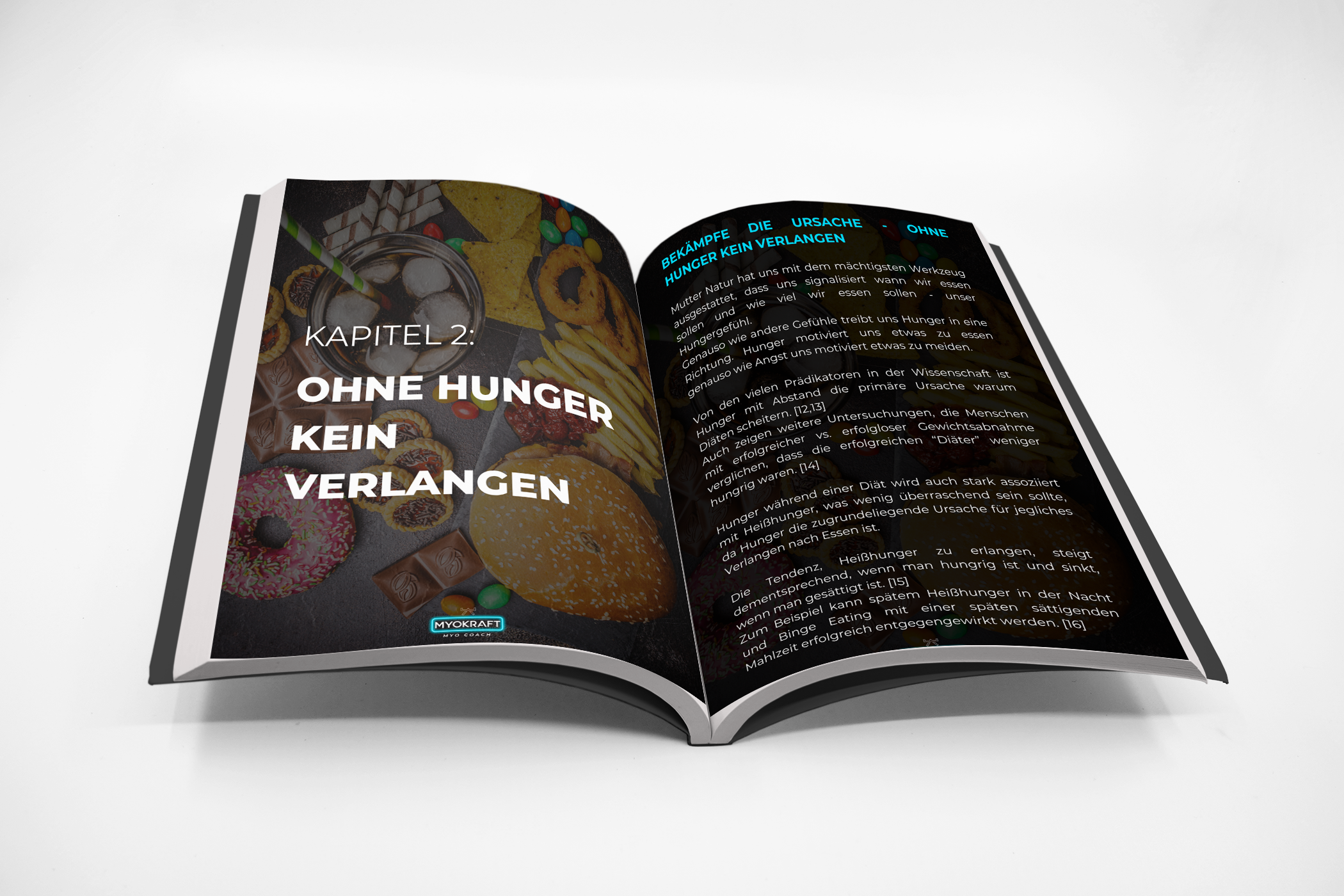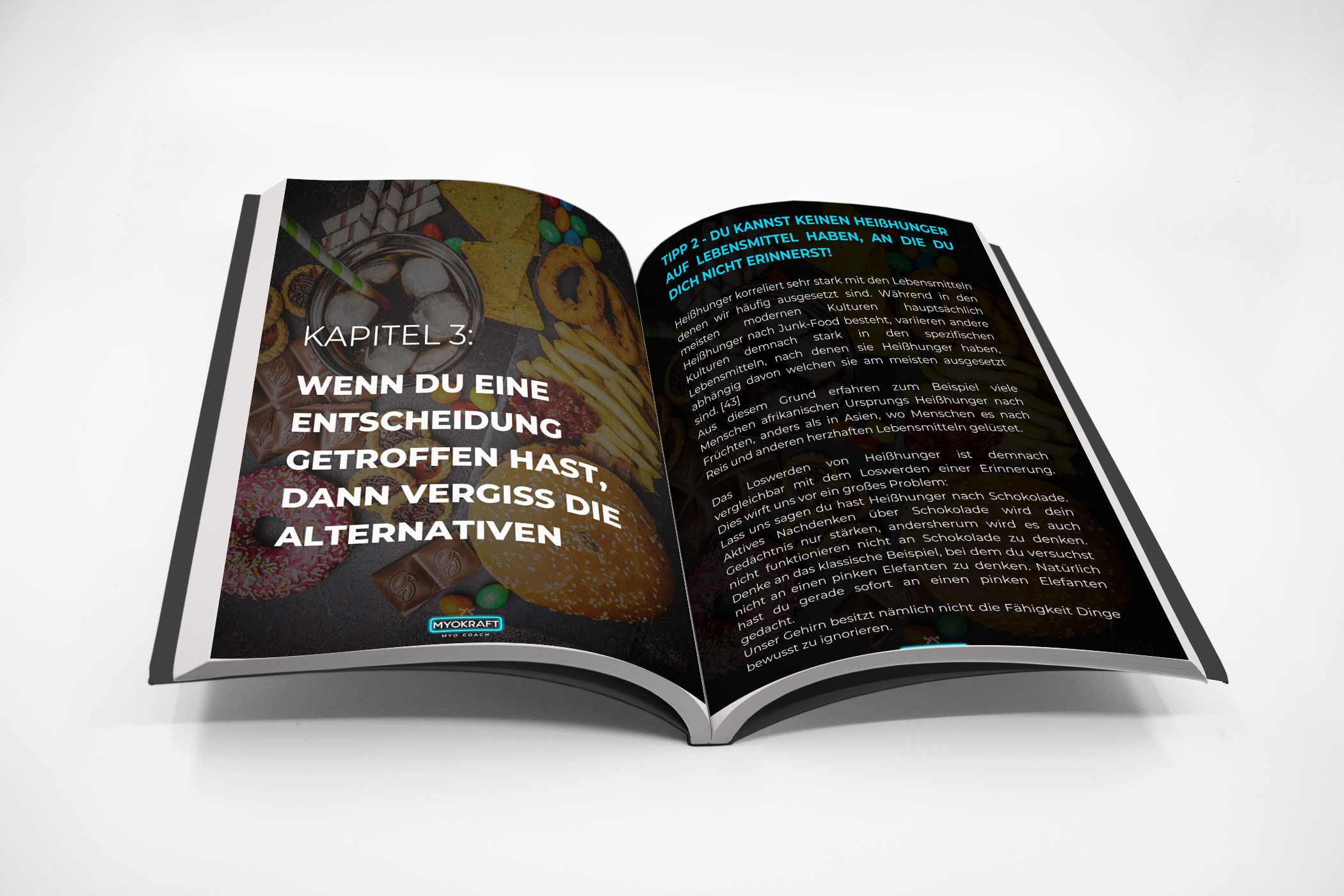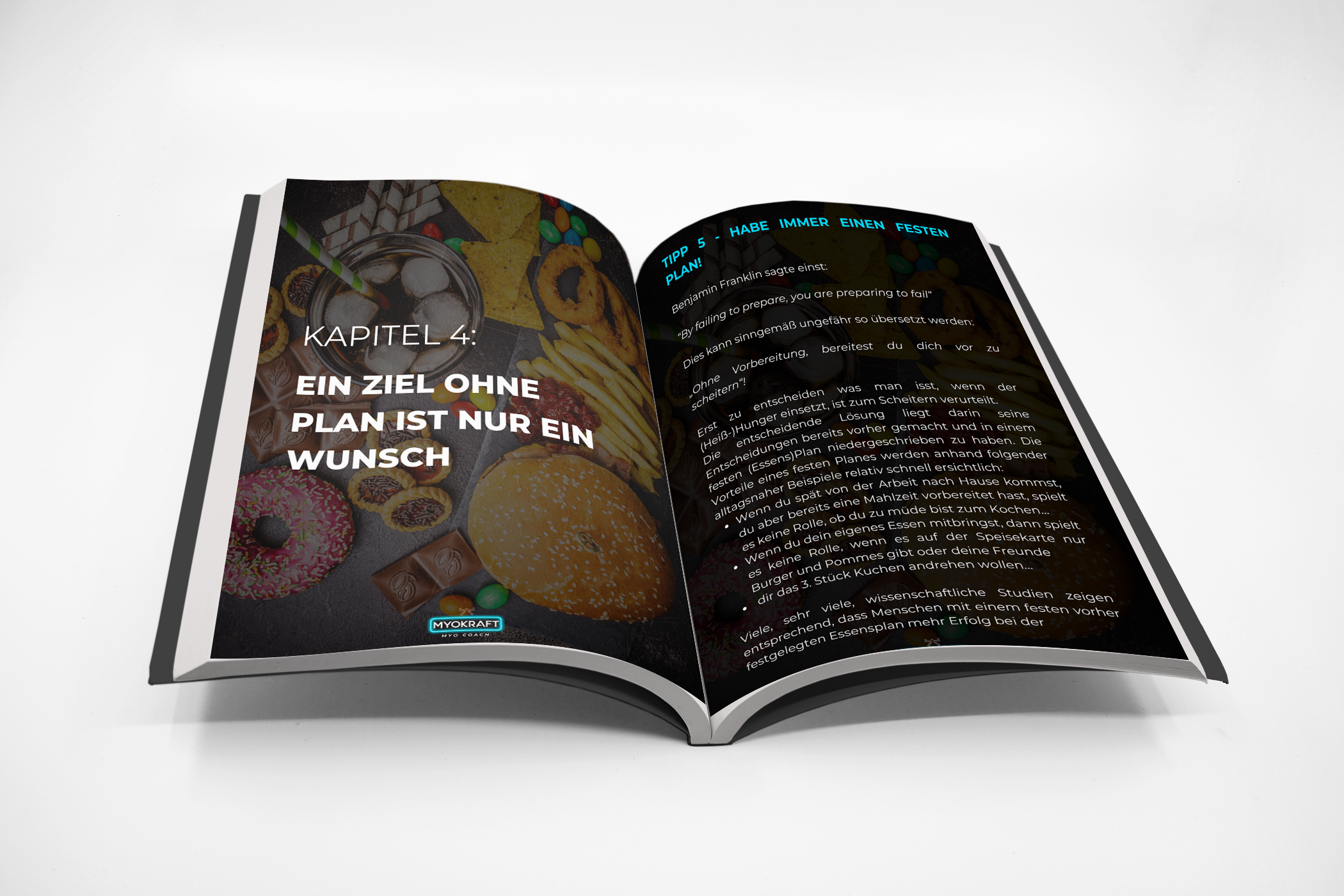AUS DIESEM BUCH
ENTSTEHUNG
Lerne was Heißhunger ist und die Mechanismen hinter der Entstehung dessen!
URSACHEN
Lerne wie du Heißhunger an der Wurzel packst und im Keim ersticken lässt!
WANDEL
Lerne wie du dich langfristig darauf konditionierst, gesundes Essen nicht nur zu mögen, sondern zu verlangen!
PLANUNG
Lerne warum explizite Planung und Vorbereitung so wichtig ist und wie sie funktioniert!
WIRF EINEN BLICK
IN DAS BUCH
SCHAU DIR DIESE
ERFOLGSGESCHICHTEN AN
LET’S GET STARTED!
Um mit dir einen geeigneten Termin zu finden beantworte uns doch bitte folgende Fragen:
Quellenangaben
- Hill J. O. (2006). Understanding and addressing the epidemic of obesity: an energy balance perspective. Endocrine reviews, 27(7), 750-761.
- White, M. A., Whisenhunt, B. L., Williamson, D. A., Greenway, F.L. & Netemeyer, R. G. (2002). Development and validation of the food-craving inventory. Obesity research, 10(2), 107-114.
- Chan, S., Gerson, B. & Subramaniam, S. (1998). The role of copper, molybdenum, selenium and zinc in nutrition and health. Clinics in laboratory medicine, 18(4), 673-685.
- Chesters, J. K. & Quaterman, J. (1970). Effects of zinc deficiency on food intake and feeding patterns of rats. The British journal of nutrition, 24(4), 1061-1069.
- Parducci, A. (1965). Category judgement: A range-frequency model. Psychological Review, 72(6), 407-418.
- Batra, P., Das, S. K., Salinardi, T., Robinson, L., Saltzman, E., Scott, T., Pittas, A. G. & Roberts, S. B. (2013). Relationship of cravings with weight loss and hunger. Results from a 6 month worksite weight loss intervention. Appetite, 69, 1-7.
- Henselmans, M. (n.d.) Why Diets Fail and “Eat Less, Move More” is a Bad Advice. Paleo f(x). https://www.paleofx.com/why-diets-fail-and-eat-less-move-more-bad-advice/
- Burger, K. S., Sanders, A. J. & Gilbert, J. R. (2016). Hedonic Hunger Is Related to Increased Neural and Perceptual Responses to Cues of Palatable Food and Motivation to Consume: Evidence from 3 Independent Investigations. The Journal of nutrition, 146(9), 1807-1812.
- Gilhooly, C. H., Das, S. K., Golden, J. K., McCrory, M. A., Dallal, G. E., Saltzman, E., Kramer, F. M. & Roberts, S. B. (2007). Food cravings and energy regulation: the characteristics of craved foods and their relationship with eating behaviors and weight change during 6 months of dietary energy restriction. International journal of obesity (2005), 31(12), 1849-1858.
- Waller, S. M., Vander Wal, J. S., Klurfeld, D. M., McBurney, M. I., Cho, S., Bijlani, S. & Dhurandhar, N. V. (2004). Evening ready-to-eat cereal consumption contributes to weight management. Journal of the American College of Nutrition, 23(4), 316-321.
- Leahey, T. M., Bond, D. S., Raynor, H., Royce, D., Vithiananthan, S., Ryder, B. A., Sax, H. C. & Wing, R. R. (2012). Effects of bariatric surgery on food cravings: do food cravings and the consumption of craved foods “normalize” after surgery? Surgery for obesity and related diseases : official journal of the American Society for Bariatric Surgery, 8(1), 84-91.
- Rolls, B. J., Roe, L. S., James, B. L. & Sanchez, C. E. (2017). Does the incorporation of portion-control strategies in a behavioral program improve weight loss in a 1-year randomized controlled trial? International journal of obesity (2005), 41(3), 434-442.
- Zuraikat, F. M., roe, L. S., James, B. L., Sanchez, C. E. & Rolls, B. J. (2018). Comparing the portion size effect in women with and without extended training in portion control: A follow-up to the Portion-Control Strategies Trial. Appetite, 123, 334-342.
- Wakisaka, S., Nagai, H., Mura, E., Matsumoto, T., Moritani, T. & Nagai, N. (2012). The effects of carbonated water upon gastric and cardiac activities and fullness in healthy young women. Journal of nutritional science and vitaminology, 58(5), 333-338.
- Rolls, B. J., Bell, E. A. & Waugh, B. A. (2000). Increasing the volume of a food by incorporating air affects satiety in men. The American journal of clinical nutrition, 72(2), 361-368.
- Rolls, B. J., Castellanos, V. H., Halford, J. C., Kilara, A., Panyam, D., Pelkman, C. L., Smith, G. P. & Thorwart, M. L. (1998). Volume of food cosumed affects satiety in men. The American journal of clinical nutrition, 67(6), 1170-1177.
- Ello-Martin, J. A., Ledikwe, J. H. & Rolls, B. J. (2005). The influence of food portion size and energy density on energy intake: implications for weight management. The American journal of clinical nutrition, 82(1 Suppl), 236S-241S.
- Holt, S. H., Miller, J. C., Petrocz, P., Farmakalidis, E. (1995). (Department of biochemistry, University of Sydney, Australia.) A satiety index of common foods. European Journal of Clinical Nutrition, 49, 675-690.
- Zhu, Y. & Hollis, J. (2013). Appetite controll and regulation of food intake: A review of proposed mechanisms. Nutritional Therapy and Metabolism, 31(2), 58-68.
- Bekelman, T. A., Santamaría-Ulloa, C., Dufour, D. L., Marín-Arias, L. & Dengo, A. L. (2017). Using the protein leverage hypothesis to understand socioeconomic variation in obesity. American journal of human biology : the offical journal of the Human Biology Council, 29(3), 10.1002/ajhb.22953.
- Morrison, C. D., reed, S. D. & Henagan, T. M. (2012). Homeostatic regulation of protein intake: in search of a mechanism. American journal of physiology. Regulatory, integrative and comparative physiology, 302(8), R917-R928.
- Efeyan, A., Comb, W. C. & Sabatini, D. M. (2015). Nutrient-sensing mechansims and pathways. Nature, 517(7534), 302-310.
- Phillips, S. M., Chevalier, S. & Leidy, H. J. (2016). Protein “requirements” beyond the RDA: implications for optimizing health. Applied physiology, nutrition, and metabolism = Physiologie appliquee, nutrition et metabolisme, 42(5), 565-572
- Henselmans, M. (n. d.). The myth of 1 g/lb: optimal protein intake for bodybuilders. MennoHenselmans.com https://mennohenselmans.com/the-myth-of-1glb-optimal-protein-intake-for-bodybuilders/
- Roberts, J., Zinchenko, A., Suckling, C., Smith, L., Johnstone, J. & Henselmans, M. (2017). The short-term effect of high versus moderate protein intake on recovery after strength training in resistance-trained individuals. Journal of the International Society of Sports Nutrition, 14, 44.
- Morton, R. W., Murphy, K. T., McKellar, S. R., Schoenfeld, B. J., Henselmans, M., Helms, E., Aragon, A. A., Devries, M. C., Banfield, L., Krieger, J. W. & Phillips, S. M. (2018). A systematic review, meta-analysis and meta regression of the effect of protein supplementation on resistance training-induced gains in muscle mass and strength in healthy adults. British journal of sports medicine, 52(6), 376-384.
- Roberts, J., Tinchenko, A., Mahbubani, K., Johnstone, J., Smith, L., Merzbach, V., Blacutt, M., Banderas, O., Villasensor, L., Vârvik, F. T. & Henselmans, M. (2018). Satiating Effect of High Protein Diets on Resistance-Trained Subjects in Energy Deficit. Nutrients, 11(1), 56.
- Li, J., Armstrong, C. L. & Campbell, W. W. (2016). Effects of Dietary Protein Source and Quantity during Weight Loss on Appetite, Energy Expenditure. and Cardio-Metabolic Responses. Nutrients, 8(2), 63.
- Howarth, N. C., Saltzman, E. & Roberts, S. B. (2001). Dietary fiber and weight regulation. Nutrition reviews, 59(5), 129-139.
- Frost, G., Sleeth, M. L., Sahuri-Arisoylu, M., Lizarbe, B., Cerdan, S., Brody, L., Anastasovska, J., Ghourab, S., Hankir, M., Zhang, S., Carling, D., Swann, J. R., Gibson, G., Viardot, A., Morrison, D., Louise Thomas, E. & Bell, J. D. (2014). The short-chain fatty acid acetate reduces appetite via a central homeostatic mechanism. Nature communications, 5, 3611.
- Eaton, S. B. & konner, M. (1985). Paleolithic nutrition. A consideration of its nature and current implications. The New England journal of medicine, 312(5), 283-289.
- Eaton S. B., Eaton S. B., 3rd, Konner, M. J. & Shostak, M. (1996). An evolutionary perspective enhances understanding of human nutritional requirements. The Journal of nutrition, 126(6), 1732-1740.
- Crum, A. J., corbin, W. R., Brwnell, K. D. & Salovey, P. (2001). Mind over milkshakes: mindsets, not just nutrients, determine ghrelin response. Health psychology: official journal of the Division of Health Psychology, American Psychological Association, 30(4), 424-431.
- Bellisle, F. & Dalix, A. M. (2001). Cognitive restraint can be offset by distraction. leading to increased meal intake in women. The American journal of clinical nutrition, 74(2), 197-200.
- Hetherington, M. M., Anderso, A. S., Norton, G. N. & Newson, L. (2006). Situational effects on mela intake: A comparison of eating alone and eating with others. Physiology & behaivor, 88(4-5). 498-505.
- Goncalves, R., Barreto, D. A., Monteiro, P. I., Zangeronimo, M. G., Castelo, P. M., van der Bilt, A. & Pereira, L. J. (2019). Smartphones use while eating increases caloric ingestion. Physiology & behaivor, 204, 93-99.
- Zellner, D. A., Garriga-Trillo, A., Rohm, E., Centeno, S. & parker, S. (1999). Food liking and craving: A cross-cultural approach. Appetite, 33(1), 61-70.
- Alberts, H. J., Mulkens, S., Smeets, M. & Thewissen, R. (2010). Coping with food cravings. Investigating the potential of a mindfulness-based intervention. Appetite, 55(1), 160-163.
- Forman, E. M., Hoffman, K. L., Juarascio, A. S., Butryn, M. L. & Herbert, J. D. (2013). Comparison of acceptance-based and standard cognitive-based coping strategies for craving sweets in overweight and obese women. Eating behaivors, 14(1), 64-68.
- Forman, E. M., Hoffman, K. L., McGrath, K. B., Herbert, J. D., Brandsma, L. L. & Lowe, M. R. (2007). A comparison of acceptance- and control-based strategies for coping with food cravings: an analog study. Behaivour research and therapy, 45(10), 2372-2386.
- Schumacher, S., Kemps, E. & Tiggemann, M. (2019). The food craving experience: Thoughts, images and resistance as predictors of craving intensity ans consumption. Appetite, 133, 387-392.
- Daniel, T. O., Stanton, C. M. & Epstein, L. H. (2013). The future is now: reducing impulsivity and energy intake using episodic future thinking. Psychological sience, 24(11), 2339-2342.
- Tapper, K. & Turner, A. (2018). The effect of a mindfulness-based decentering strategy on chocolate craving. Appetite, 130, 157-162
- Hollis-Hansen, K., Seidman, J., O´Donnell, S. & Epstein, L. H. (2019). Episodic future thinking and grocery shopping online. Appetite, 133, 1-9.
- Yang, Y., Shields, G. S., Wu, Q., Liu, Y., Chen, H. & Guo, C. (2019). Cognitive training on eating behaviour and weight loss: A meta-analysis and systematic review. Obesity reviews: an official journal of the International Association for the Study of Obesity, 20(11), 1628-1641.
- Wansink, B., Painter, J. E. & Lee, Y. K. (2006). The office candy dish: proximity´s influence on estimated and actual consumption. International journal of obesity (2005), 30(5), 871-875.
- ApolzaN, J. W., Myers, C. A., Champagne, C. M., Beyl, R. A., Raynor, H. A., Anton, S. A., Williamson, D.A., Sacks, F. M., Bray, G. A. & Martin, C. K. (2017). Frequency of Consuming Foods Predicts Changes in Cravings for Those During Weight Loss: The POUNDS Lost Study. Obesity (Silver Spring Md.), 25(8), 1343-1348.
- Anguah, K. O., Syed-Abdul, M. M., Hu, Q., Jacome-Sosa, M., Heimowitz, C., Cox, V. & Parks, E. J. (2019). Changes in Food Cravings and Eating Behavior after a Dietary Carbohydrate Restriction Intervention Trial. Nutrients, 12(1), 52.
- Gilhooly, C. H., Das, S. K., Golden, J. K., McCrory, M. A., Dallal. G. E., Saltzman, E., Kramer, F. M. & Roberts, S. B. (2007). Foos cravings and energy regulation: the characteristics of craved foods and their relationship with eating behaviors and weight change during 6 months of dietary energy restriction. International journal of obesity (2005), 31(12), 1849-1858.
- Barnes, R. D. & Tantless-Dunn, S. (2010). Food for thought: examing the relationship between food thought suppression and weight-related outcomes. Eating behaviors, 11(3), 175-179.
- Richard, A., Meule, A., Friese, M. & Blechert, J. (2017). Effects of Chocolate Deprivation on Implicit and Explicit Evaluation of Chocolate in High and Low Trait Chocolate Cravers. Frontiers in psychology, 8, 1591.
- Loria-Kohen, V., Gómez-Candela, C., Fernández-Fernández, C., Pérez-Torres, A., García-Puig, J. & Bermejo, L. M. (2012). Evaluation of the usefulness of a low-calorie diet with or without bread in the treatment of overweight/obesity. Clinical nutrition (Edinburgh, Scotland), 31(4), 455-461.
- Trudel, R. & Murray, K. B. (2013). Self-regulatory strength amplification through selective information processing. Journal of Consumer Psychology, 23(1), 61-73.
- Koehler, D. J. & Harvey, N. (2004). Blackwell Handbook of Judgment and Decision Making. Wiley-Blackwell.
- Lampuré, A., Schlich, P., Deglaire, A., Castetbon, K., Péneai, S., Hercberg, S. & Méjean, C. (2015). Sociodemographic, psychological, and lifestyle characteristics are associated with a liking for salty and sweet tastes in French adults. The Journal of nutrition, 145(3), 587-594.
- Holt, S.H.A., Cobiac, L., Beaumont-Smith, N. E., Easton, K. & Best, D. J. (2000). Dietary habits and the perception and liking of sweetness among Australian and Malaysian students: A cross-cultural study. Food Quality and Preference, 11(4), 299-312.
- Jamel, H. A., Sheiham, A., Cowell, C. R. & Watt, R. G. (1996). Taste preference for sweetness in urban and rural populations in Iraq. Journal of dental research, 75(11), 1879-1884.
- Lee, J. (2001(. Diet Programs and Compliance: Do Prepared Meal Programs Increase Adherence? Nutrition Bytes, 7(1).
- Wing, R. R., Jefferay, R. W., Burton, L. R., Thorson, C., Nissinoff, K. S. & Baxter, J. E., (1996). Food provision vs structured meal plans in the behavioral treatment of obesity. International journal of obesity and related metabolic disorders: journal of the International Association for the Study of Obesity, 20(1), 56-62.
- Metz, J. A., Kris-Etherton, P. M., Morris, C. D., Mustad, V. A., Stern, J. S., Oparil, S., Chait, A., Haynes, R. B., Resnick, L. M., Clark, S., Hatton, D. C., McMahon, M., Holcomb, S., Snyder, G. W., Pi-Sunyer, F. X. & McCarron, D. A. (1997). Dietary complience and cardiovascular risk reduction with a prepared meal plan compared with a self-selected diet. The American journal of clinical nutrition, 66(2), 373-385.
- Pi-Sunyer, F. X., Maggio, C. A., McCarron, D. A., Reusser, M. E., Stern, J. S., Hatton, D. C., Metz, J. A., Snyder, G. W., Clark, S. & McMahon, M. (1999). Multicenter randomized trial of a comprehensive prepared meal program in type 2 diabetes. Diabetes care, 22(2), 191-197.
- Hatton, D. C., Haynes, R. B., Oparil, S., Kris-Etherton, P., Pi-Sunyer, F. X., Resnick, L. M., Stern, J. S., Clark, S., McMahon, M., Morris, C., Metz, J., Ward, A., Holcomb, S. & McCarron, D. A., (1996). Improved quality of life in patients with generalized cardiovascular metabolic disease on a prepared diet. The American journal of clinical nutrition, 64(6), 935-943.
- McCarron, D. A., Oparil, S., Chait, A., Haynes, R. B., Kris-Etherton, P., Stern, J. S., Resnick, L. M., Clark, S., Morris, C. D., Hatton, D. C., Metz, J. A., McMahon, M., Holcomb, S., Snyder, G. W. & Pi-Sunyer, F. X. (1997). Nutritional management of cardiovascular risk factors. A randomized clinical trial. Archives of internal medicine, 157(2), 169-177.
- Metz, J. A., Stern, J. S., Kris-Etherton, P., Reusser, M. E., Morris, C. D., Hatton, D. C., Oparil, S., Haynes, R. B., Resnick, L. M., Pi-Sunyer, F. X., Clark, S., Chester, L., McMahon, M., Snyder, G. W. & McCarron, D. A. (2000). A randomized trial of improved weigth loss with a prepared meal plan in overweight and obese patients: impact on cardiovascular risk reduction. Archives of internal medicine, 160(14), 2150-2158.
- Rock, C. L., Flatt, S. W., Sherwood, N. E., Karanja, N., Pakiz, B. & Thomson, C. A. (2010). Effect of a free prepared meal and incentivized weight loss program on weight loss and weight loss maintenance in obese and overweight women: a randomized controlled trial. JAMA, 304(16), 1803-1810.
- Haynes, R. B., Kris-Etherton, P., McCarron, D. A., Oparil, S., Chait, A., Resnick, L. M., Morris, C. D., Clark, S., Hatton, D. C., Metz, J. A., McMahon, M., Holcomb, S., Snyder, G. W., Pi-Sunyer, F. X. & Stern, J. S. (1999). Nutritionally complete prepared meal plan to reduce cardiovascular risk factors: a randomized clinical trial. Journal of the American Dietetic Association, 99(9), 1077-1083.
- Flechtner-Mors, M., Ditschuneit, H. H., Johnson, T. D., Suchard, M. A. % Adler, G. (2000). Metabolic and weight loss effects of long-term dietary intervention in obese patients: four-year results. Obesity research, 8(5), 399-402.
- Ducrot, P., Méjean, C., Aroumougame, V., Ibanez, G., Alléz, B., Kesse-Guyot, E., Hercberg, S. & Péneau, S. (2017). Meal planning is associated with food variety, diet quality and body weight status in a large sample of French adults. The international journal of behavioral nutrition and physical activity, 14(1), 12.
- Solianik, R. & Sujeta, A. (2018). Two-day fasting evokes stress, but does not affect mood, brain activity, cognitive, psychomotor, and motor performance in overweight women. Behavioral brain research, 338, 166-172.
- Solianik, R., Sujeta, A., Terentjeviene, A. & Skurvydas, A. (2016). Effect of 48 h Fasting on Autonomic Function, Brain Activity, Cognition, and Mood in Amateur Weight Lifters. BioMed research international, 2016, 1503956.
- Martin, C. K., Anton, S. D., Han, H., York-Crowe, E., Redman, L. M., Ravussin, E. & Williamson, D. A. (2007). Examination of cognitive function during six months of calorie restriction: results of a randomized controlled trial. Rejuvenation research, 10(2), 179-190.
- Herzog, N., Friedrich, A., Fujita, N., Gais, S., Jauch-Chara, K., Oltmanns, K. M. & Benedict, C. (2012). Effects of a daytime food intake on memory consolidation during sleep or sleep deprivation. PloS one, 7(6), e40298.
- Wadden, T. A., Stunkard, S. J., Day, S. C., Gould, R. A. & Rubin, C. J. (1987). Less food, less hunger: reports of appetite and symptoms in a controlled study of a protein-sparing modified fast. International journal of obesity, 11(3), 239-249.
- Grigolon, R. B., Brietzke, E., Trevizol, A. P., McIntyre, R. S. & Mansur, R. B. (2020). Caloric restriction, resting metabolic rate and cognitive performance in Non-obese adults: A post-hoc analysis from CALERIE study. Journal of psychiatric research, 128, 16-22.
- Leclerc, E., Trevizol, A. P., Grigolon, R. B., Subramaniapillai, M., McIntyre, R. S., Brietzke, E. & Mansur, R. B. (2020). The effect of caloric restriction on working memory in healthy non-obese adults. CNS spectrums, 25(1), 2-8.
- Green, M. W., Elliman, N. A. & Roggers, P. J. (1997). The effects of food deprivation and incentive motivation on blood glucose levels and cognitive function. Psychopharmacology, 134(1), 88-94.
- Attuquayefio, T. & Stevenson, R. J. (2015). A systematic review of longer-term dietary interventions on human cognitive function: Emerging patterns and future directions. Appetite, 95, 554-570.
- Booth, A. O., Wang, X., Turner, A. I., Nowson, C. A. & Torres, S. J. (2018). Diet-Induced Weight Loss Has No Effect on Psychological Stress in Overweight and Obese Adults: A Meta-Analysis of Randomized Controlled Trials. Nutrients, 10(5), 613.
- Kuk, J. L., Christensen, R. & Wharton, S. (2019). Absolute Weight Loss, and Not Weight Loss Rate, Is Associated with Better Improvements in Metabolic Health. Journal of obesity, 2019, 3609642.
- Huynh, C. (n.d.). The truth about processed vs unprocessed foods. MennoHenselmans.com. https://mennohenselmans.com/processed-foods/
- Caristia, S., Vito, M., Sarro, A., Leone, A., Pecere, A., Zibetti, A., Filigheddu, N., Zeppegno, P., Prodam, F., Faggiono, F. & Marzullo, P. (2020). Is Caloric Restriction Associated with Better Healthy Aging Outcomes? A systematic Review and Meta-Analysis of Randomized Controlled Trials. Nutrients, 12(8), 2290.
- Heilbronn, L. K. & Ravussin, E. (2003). Calorie restriction and aging: review of the literature and implications for studies in humans. The American journal of clinical nutrition, 78(3), 361-369.
- Heilbronn, L. K., de Jonge, L., Frisard, M. I., DeLany, J. P., Larson-Meyer, D. E., Rood, J., Nguyen, T., Martin, C. K., Volaufova, J., Most, M. M., Greenway, F. L., Smith, S. R., Deutsch, W. A., Williamson, S. A., Ravussin, E. & Pennington CALERIE Team (2006). Effect of 6-month calorie restriction on biomarkers of longevity, metabolic adaptation, and oxidative stress in overweight individuals: a randomized controlled trial. JAMA, 295(13), 1539-1548.
- Ravussin, E., Redman, L. M., Rochon, J., Das, S. K., Fontana, L., Kraus, W. E., Romashkan, S., Williamson, D. A., Meydani, S. N., Villareal, D. T., Smith, S. R., Stein, R. I., Scott, T. M., Stewart, T. M., Saltzman, E., Klein, S., Bhapkar, M., Martin, C. K., Gilhooly, C. H., Holloszy, J. O., … CALERIE Study Group (2015). A 2-Year Randomized Controlled Trial of Human Caloric Restriction: Feasibility and Effects on Predictors of Health Span and Logevity. The journals of gerontology. Series A, Biological sciences and medical sciences, 70(9), 1097-1104.
- de Cabo, R., Carmona-Gutierrez, D., Bernier, M., Hall, M. N. & Madeo, F. (2014). The search for antiaging interventions: from elixirs to fasting regimens. Cell, 157(7), 1515-1526.
- Broskey, N. T., Marlatt, K. L., Most, J., Erickson, M. L., Irving, B. A. & Redman, L. M. (2019). The Panacea of Human Aging: Caloric Restriction Versus Exercise. Exercise and sport siences reviews, 47(3), 169-175.
- Steel, D., Kemps, E. & Tiggemann, M. (2006). Effects of hunger and visuo-spatial interference on imagery-induced food cravings. Appetite, 46(1), 36-40.
- Morris, J., Keith Ngai, M. Y., Yeomans, M. R. & Forester, S. (2020). A high perceptual load task reduces thoughts about Chocolate, even while hungry. Appetite, 151, 104694.
- Magnuson, B. A., Burdock, G. A., Doull, J., Kroes, R. M., Marsh, G. M., Pariza, M. W., Spencer, P. S., Waddell, W. J., Walker, R. & Williams, G. M. (2007). Aspartame: a saety evaluation based on current use levels, regulations, and toxicological and epidemiological studys. Critical reviews in toxicology, 37(8), 629-727.
- Grotz, V. L. & Munro, I. C. (2009). An overview of the safety of sucralose. Regulatory toxicology and pharmacology: RTP, 55(1), 1-5.
- Henselmans, M. (n.d.). Is aspartame safe? MennoHenselmans.com. https://mennohenselmans.com/is-aspartame-safe/
- Farshchi, H. R., Taylor, M. A. & Macdonald, I. A. (2004). Regular meal frequency creates more appropiate insulin sensitivity and lipid profiles compared with irregular meal frequency in healthy lean women. European journal of clinical nutrition, 58(7), 1071-1077.
- Witbracht, M., Keim, N. L., Forester, S., Widaman, A. & Laugero, K. (2015). Female breakfast skippers display a disrupted cortisol rhythm and elevated blood pressure. Physiology & behavior, 140, 215-221.
- Thomas, E. A., Higgins, J. Bessesen, D. H., McNair, B. & Cornier, M. A. (2015). Usual breakfast eating habits affect response to breakfast skipping in overweight women. Obesity (Silver Spring, Md.), 23(4), 750-759.
- Alhussain, M. H., Macdonald, I. A. & Taylor, M. A. (2016). Irregular meal-pattern effects on energy expenditure, metabolism, and appetite regulation: a randomized controlled trial in healthy normal-weight women. The American journal of clinical nutrition, 104(1), 21-32.
- Elfhag, K. & Rössner, S. (2005). Who succeeds in maintaining and weight loss? A conceptual review of factors associated with weight loss maintenance and weight regain. Obesity reviews : an official journal of the International Association for the Study of Obesity, 6(1), 67-85.
- Smith, C. F., Williamson, D. A., Bray, G. A. & Ryan, D. H. (1999). Flexible vs. Rigid dieting stategies: relationship with adverse behavioral outcomes. Appetite, 32(3), 295-305.
- Stewart, T. M., Williamson, D. A. & White, M. A. (2002). Rigid vs. flexible dieting: association with eating disorder symptoms in nonobese women. Appetite, 38(1), 39-44.
- Tylkaa, T. L., Calogerob, R. M. & Daníelsdóttir, S. (2015). Is intuitive eating the same as flexible dietary control? Their links to each other and well-being could provide an answer. Appetite, 95, 166-175.
- Teixeira, P. J., Carraca, E. V., Marques, M. M., Rutter, H., Oppert, J. M., De Bourdeaudhuij, I., Lakerveld, J. & Brug, J. (2015). Successful behavior change in obesity interventions in adults: a systematic review of self-regulation mediators. BMC medicine, 13, 84.
- Palascha, A., van Kleef, E., van Trijp, H. C.. How dies thinking in Black and White terms relate to eating behaivor and weight regain? J Health Psychol. 2015 May;20(5):638-648.
- Camilleri, G. M., Méjean, C., Bellisle, F., Andreeva, V. A., Kesse-Guyot, E., Hercberg, S. & Péneau, S. (2017). Intuitive Eating Dimensions Were Differently Associated with Food Intake in the General Population-Based NutriNet-Santé Study. The Journal of nutrition, 147(1), 61-69.
- Varkevisser, R., van Stralen, M. M., Kroeze, W., Ket, J. & Steenhuis, I. (2019). Determinants of weight loss maintenance: a systematic review. Obesity reviews : an officioal journal of the International Association for the Study of Obesity, 20(2). 171-211.
- Kashdan, T. B. & Rottenberg, J. (2020). Psychological flexibility as a fundamental aspect of health. Clinical psychology review, 30(7), 865-878.
- Van Dyké, N. & Drinkwater, E. J. (2014). Relationships between intuitive eating and health indicatiors: literature review. Public health nutrition, 17(8), 1757-1766.


